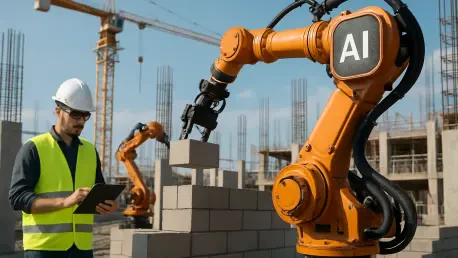What if a single technology could cut through the inefficiencies of an industry as old as construction itself, saving millions in time and resources while enhancing safety? Balfour Beatty, a global leader in infrastructure, is turning this possibility into reality by integrating artificial intelligence into its operations. This transformation is not just a trend but a seismic shift, promising to redefine how projects are planned, executed, and delivered in a sector often criticized for lagging in innovation.
The Power of AI in Reshaping Construction
Artificial intelligence stands as a transformative force in construction, an industry historically tied to manual processes and incremental change. By leveraging AI, companies can predict project risks, optimize resource allocation, and reduce costs by significant margins—studies suggest up to a 20% reduction in project overruns with predictive analytics. Balfour Beatty’s adoption of this technology signals a broader movement toward efficiency in a field ripe for disruption.
This shift matters because construction impacts economies and communities worldwide, from skyscrapers to highways. Delays and budget overruns often burden taxpayers and stakeholders, making AI’s potential to streamline operations a critical development. Balfour Beatty’s bold steps in this arena position it as a pioneer, addressing age-old challenges with cutting-edge solutions.
Why Construction Needs Digital Innovation Now
The construction sector faces unrelenting pressures—escalating costs, labor shortages, and ever-tightening safety regulations. These challenges demand more than traditional methods; they require a digital overhaul to keep pace with global demands. Balfour Beatty recognizes that without technological intervention, inefficiencies will continue to plague projects, affecting timelines and bottom lines.
Beyond internal benefits, digital transformation influences the wider community. Infrastructure projects, such as roads and bridges, shape daily life, and delays or failures disrupt more than just budgets—they impact safety and accessibility. AI offers a path to mitigate these issues, ensuring projects are completed on time and within scope, a priority that Balfour Beatty has embraced with urgency.
Inside Balfour Beatty’s AI Blueprint
At the heart of Balfour Beatty’s strategy lies a $9.6 million investment in Microsoft 365 Copilot and custom AI agents, aimed at revolutionizing core operations. This initiative focuses on automating mundane tasks like quality assurance checks, freeing up engineers for complex problem-solving. The technology also enhances health and safety by flagging potential hazards before they become incidents.
A prime example unfolds at the A9 road improvement project in Scotland, a $247 million endeavor upgrading highways and constructing bridges. Here, AI streamlines inspection and test plans, identifying errors in templates that once consumed hours of manual review. This pilot showcases tangible gains—improved consistency and redirected focus toward high-value engineering tasks, proving AI’s real-world impact.
The scope of this innovation extends beyond a single project. Balfour Beatty’s tailored AI solutions operate within a secure IT environment, prioritizing data protection over generic tools. This careful balance of progress and security underscores a thoughtful approach to integrating technology into a traditionally cautious industry.
Leadership Perspectives and Early Wins
Chief Information Officer Jon Ozanne views AI as a cornerstone of Balfour Beatty’s future, not merely a shiny new tool. His emphasis lies in ensuring resilience and maintaining a competitive edge while safeguarding sensitive data through robust cybersecurity measures. This perspective highlights a strategic vision that goes beyond adoption to long-term sustainability.
Early results from the A9 project trial reinforce this optimism. Feedback indicates a notable reduction in manual errors during inspections, a win for both efficiency and accuracy. Such outcomes suggest that AI can fundamentally alter workflows, setting a benchmark for what’s possible when technology meets infrastructure.
Expert commentary further validates this trajectory. Industry analysts note that Balfour Beatty’s investment aligns with a growing consensus that AI will become indispensable in construction over the next few years, from 2025 onward. This forward-thinking stance offers a model for others navigating similar challenges in a competitive landscape.
Practical Lessons from Balfour Beatty’s AI Journey
Balfour Beatty’s approach provides a roadmap for other firms eager to harness AI in construction. A starting point lies in pinpointing repetitive processes—like documentation or compliance checks—that drain time and resources, making them ideal candidates for automation. This targeted focus ensures maximum impact with minimal disruption.
Security remains paramount, and adopting customized AI tools over off-the-shelf options helps protect proprietary data. Balfour Beatty’s emphasis on a secure IT framework serves as a reminder that innovation must not compromise confidentiality. Companies of all sizes can learn from this by prioritizing tailored solutions.
Finally, beginning with pilot programs offers a low-risk way to test and refine AI applications. The success at the A9 project illustrates how small-scale trials can build confidence and scalability. This phased strategy allows firms to adapt technology to specific needs, paving the way for broader implementation across diverse projects.
Reflecting on a Digital Milestone
Looking back, Balfour Beatty’s nearly $10 million investment in AI marked a defining moment in construction’s digital evolution. The strides made through initiatives like the A9 project in Scotland revealed how automation could elevate efficiency and precision in ways previously unimagined. This journey highlighted technology’s role in addressing entrenched industry challenges.
The path ahead calls for broader collaboration across the sector to scale these innovations. Companies are encouraged to explore AI with an eye toward customization and security, ensuring that progress aligns with practical needs. Balfour Beatty’s example sets a precedent, urging others to invest in solutions that could transform infrastructure for generations to come.









